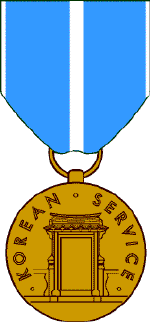
The Korean War was significant in the fact that it was the first war in which the newly independent United States Air Force was involved.
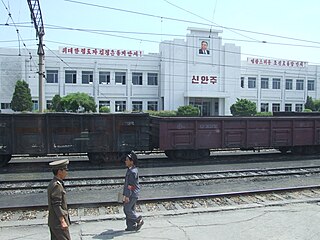
Sinanju is a region (신안주) in Anju city, South Pyongan Province, North Korea. The name literally means "Comfortable New Village." When Anju County was raised to the status of a city in August 1987, Sinanju Workers' District was divided into Sinwon-dong, Wonhung-dong, Yokchon-dong.

The Twentieth Air Force (Air Forces Strategic) (20th AF) is a numbered air force of the United States Air Force Global Strike Command (AFGSC). It is headquartered at Francis E. Warren Air Force Base, Wyoming.

The Blockade of Wonsan, or the Siege of Wonsan, from February 16, 1951 to July 27, 1953, during the Korean War, was the longest naval blockade in modern history, lasting 861 days. United Nations naval forces, primarily from the United States, kept the strategically-important city of Wonsan from being used by the North Korea Navy.

The attack on the Sui-ho Dam was the collective name for a series of mass air attacks during the Korean War on thirteen hydroelectric generating facilities by United Nations Command air forces as part of the North Korean bombing campaign on June 23–24 and June 26–27, 1952. Primarily targeting the hydroelectric complex associated with the Sui-ho Dam in North Korea, the attacks were intended to apply political pressure at the stalled truce negotiations at Panmunjeom.

The 92d Operations Group is the flying component of the 92d Air Refueling Wing, assigned to the United States Air Force Air Mobility Command Eighteenth Air Force. The group is stationed at Fairchild Air Force Base, Washington.
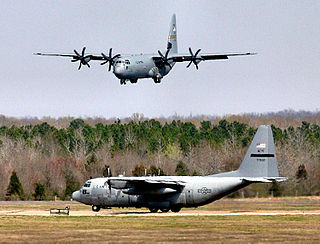
The 19th Operations Group is the operational flying component of the United States Air Force 19th Airlift Wing, stationed at Little Rock Air Force Base, Arkansas.

The United States Air Force in South Korea is composed of units assigned to Pacific Air Forces Seventh Air Force. The mission of the personnel, equipment and aircraft is to deter, protect and defend the Republic of Korea from attack from the Democratic People's Republic of Korea (DPRK) or more commonly known as North Korea.
This is the order of battle for United Nations and North Korean forces during the Battle of Pusan Perimeter in August and September 1950 during the Korean War. The engagement brought each side to muster substantial ground, air and sea resources to fight across southeastern Korea.
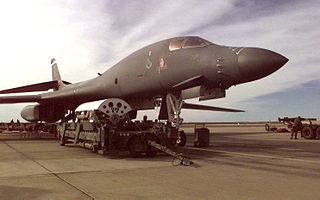
The 345th Bomb Squadron is a United States Air Force Reserve squadron, assigned to the 489th Bomb Group. It is stationed at Dyess Air Force Base, Texas, where it is an associate unit of the 7th Bomb Wing.
Sinuiju Airfield(신의주공항) is an airport near Sinuiju, Pyongan-bukto, North Korea.
Mirim Airport, also known as Pyongyang East Airfield or K-24 Air Base, is an airport in Mirim-dong, Sadong-guyok, Pyongyang-si, North Korea.

Logistics in the Battle of Pusan Perimeter during the Korean War played a decisive role in the battle. Efficient logistics, the management of personnel and materiel, supported United Nations (UN) supply lines while the North Koreans' routes of supply were steadily reduced and cut off. UN logistics improved throughout the Battle of Inchon and the defeat of the North Korean army at Pusan.
The Air Battle of South Korea was an air campaign early in the Korean War occurring roughly from 25 June to 20 July 1950 over South Korea between the air forces of North Korea and the United Nations, including the countries of South Korea, the United States and the United Kingdom. The month-long fight for air supremacy over the country included several small engagements over airfields in Seoul and Taejon and ultimately ended in victory for the UN air force, which was able to destroy the small North Korean People's Air Force.
Pyongyang Air Base also known as Heijo Airfield or Pyongyang (K-23) Air Base was a former Imperial Japanese Army Air Service, Korean People's Air Force (KPAF) and United States Air Force (USAF) air base adjacent to the Taedong River in Pyongyang, North Korea. It was redeveloped after the Korean War as a Government and residential area.

Yonpo Airfield(련포비행장), also known as Yonpo Air Base or K-27 Air Base, is an airport near Hamhung, South Hamgyong Province, North Korea.
Operation Strangle was a sustained interdiction attack on North Korea's supplies and communications by the United Nations forces during the Korean War. Beginning in August 1951, the campaign's 87,552 interdiction sorties were credited with destroying 276 locomotives, 3,820 railroad cars, 19,000 rail cuts, and 34,211 other vehicles. The North Koreans countered the campaign by moving anti-aircraft (AA) guns and crews towards the front line and placing them in higher concentrations around important targets, causing heavy casualties in the UN forces. Despite high losses, Operation Strangle destroyed 900 AA gun positions and damaged 443.
The UN offensive into North Korea was a large-scale offensive in late 1950 by United Nations (UN) forces against North Korean forces during the Korean War.
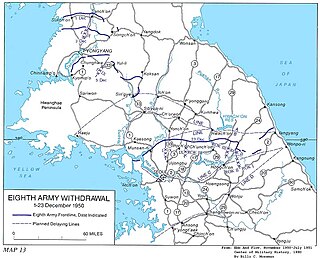
The UN Forces retreat from North Korea was the withdrawal of United Nations (UN) forces from North Korea that took place from 2–25 December 1950.












